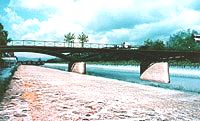|
Top Picks || Arts & Entertainment || Business & Economy || Education & Society ||
NOT IN THIS TOWN: Proposal Scrapped for French-Style Bridge in Kyoto October 5, 1998  The proposed Pont des Arts replica in Kyoto. (Jiji Press) A recent proposal to construct a replica of bridge, the Paris' famous Pont des Arts, over the Kamo River in the heart of Kyoto, the ancient capital of Japanese tradition, was meant to celebrate the Year of France in Japan and the fortieth anniversary of the sister-city relationship between Kyoto and Paris. What seemed at first an ideal way to further link the two cultural cities ran into furious public opposition, however, and the plan to construct the French-style bridge was abandoned in August 1998. This difference of opinion between the local government and Kyoto's citizens seems to herald the beginning of a major debate in Japan on the nature of public art. A Tale of Two Cities The pedestrian bridge proposed in Kyoto would have had the same kind of steel frame as the Pont des Arts, and the structure and design would have been similar. City planners saw the bridge as an ideal way to strengthen ties between the sister cities and to stress Kyoto's status as a city of art and culture. In response to the argument that a European-style bridge in Kyoto would look odd, the designers at one point tried to come up with a mixture of East and West. For example, after conducting a survey among citizens on lighting options, they suggested that Japanese-style lanterns should be incorporated. But these concessions were not enough to quell bridge opponents, who pressured the administration to cancel construction. Some local citizens expressed concern that Pontocho, the traditional neighborhood at one end of the proposed bridge, would suffer from the presence of a European structure. Many people questioned the concept in general, wondering why Kyoto needed a French-style bridge at all. Project Still Up In the Air The Kyoto municipal government has not abandoned the idea of building a bridge itself. Some experts believe that this is a good chance to show Kyoto's sense of public art. But there is a strong feeling that Kyoto, the treasure-house of Japanese art, clouded the issue by proposing to borrow from the West. Now the whole of Japan is watching with even more interest than before to see what kind of design the planners will come up with next.
 Edited by Japan Echo Inc. based on domestic Japanese news sources. Articles presented here are offered for reference purposes and do not necessarily represent the policy or views of the Japanese Government. Edited by Japan Echo Inc. based on domestic Japanese news sources. Articles presented here are offered for reference purposes and do not necessarily represent the policy or views of the Japanese Government.
|
